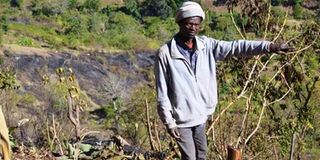Residents of landslide-prone Tharaka-Nithi want to be evacuated ahead of El Niño

Mr Joseph Gitonga points at the Nithi Valley where his two cows perished following a landslide during the he 1997/98 El Niño rains. Nithi residents are now living in fear that with the rains forecast to hit many parts of the country in a matter of weeks, they are yet to be evacuated from the hillsides. ALEX NJERU | NATION MEDIA GROUP
What you need to know:
- Ms Kangai Mugendi who lives in Ngongu Village on one side of the valley says they are moved before the rains start.
- She said that they were forced to take refuge at Mitheru Chief’s camp for close to two months during the 1997/98 El Niño rains.
- Lucy Ciamati, 83, said they settled in the valley in 1986 after the Nyayo Tea Zones were established.
- Justus Mitambo questioned the county government’s preparedness to handle such a disaster.
Tharaka-Nithi County is among areas most prone to landslides with several cases being reported in the past.
Residents are now concerned that with the expected El Niño rains forecast to hit many parts of the country in a matter of weeks, they are yet to be evacuated.
The El Niño rains, Kenya Meteorological Department has warned, will fall throughout the country starting October.
Although the county and national governments have been holding meetings to formulate measures to save lives and reduce losses, the residents feel that the process is too slow.
According to Ms Kangai Mugendi who lives in Ngongu Village on one side of the valley, it is important that they are moved before the rains start.
During a visit by the Nation, Ms Mugendi, a mother of three, said during the 1997/98 El Niño rains, there were a lot of damages.
She said that they were forced to take refuge at Mitheru chief’s camp for close to two months.
ANIMALS BURIED ALIVE
“Our animals were buried alive and we lost a lot of property. After the rains subsided, many open cracks appeared and for fear of children falling in them we are forced to keep an eye on them at all times.
“Sometimes we are forced to tie the crawling ones to trees so that they do not go far,” she said.
She however says that a good amount of rain is needed to revive agriculture in the area.
Lucy Ciamati, 83, said they settled in the valley in 1986 after the Nyayo Tea Zones were established.
Ms Ciamati recalled how her neighbours bought land in the upper sides of Kiangondu and Mitheru after they were forced out of their farms to allow for the establishment of the tea plantations.
“The poor had to settle in the valley because they had no money to buy land elsewhere,” said Ms Ciamati.
She added that government officials have visited the landslide-prone village several times and recommended that people be moved to safe areas.
According to former councilor Jackson Njeru, the late Jeremiah Nyaga who was then Minister for Lands during retired President Moi’s government, visited the area and recommended about 50 households be allocated small portions of land on the flat Nyayo Tea Zone area.
Ms Martha Karua, when she was Minister for Water, also visited the valley and recommended the same but nothing has happened so far.
With the announcement of the coming of El Nino rains, the locals are calling on the government to evacuate them to the safe places.
Justus Mitambo a village elder and a Nyumba Kumi committee member questioned the county government’s preparedness to handle such a disaster.
But the county Urban and Disaster Management executive Tabitha Mbungu said they have put in place measures to mitigate against any disaster.
She assured residents that they will be evacuated before the rains start.





